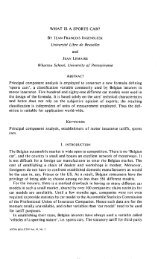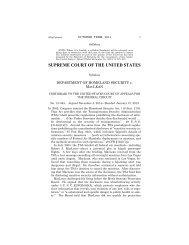85jct_catalan
Create successful ePaper yourself
Turn your PDF publications into a flip-book with our unique Google optimized e-Paper software.
260 E.tiRLINC;tR AND HOFBAL!EH<br />
(5.1) is just (3.5) (5.2) is (3. I ). and (5.3)(5.5) are recurrence relations<br />
extending (1.2).<br />
(3) Surprisingly the Carlitz q-Catalan numbers also are covered by<br />
them, as we recognize from (5.2) by setting u = q ‘, h = q’, .Y = q I. and<br />
comparing with (2.5):<br />
C,,(q<br />
‘; q ?, q2) = q -W,(q)<br />
or<br />
c?(q) = C,(q; q2, q~-2L<br />
But then (5.1) implies that the two statistics “(‘;) - inv” and<br />
“2ct - 2p + des” have the same distribution on %,;,. One can show that they<br />
are also equally distributed on S(n, n). We will give a “bijective proof’ of<br />
this fact in the next section,<br />
(4) It would be interesting to extend the above theorem further by<br />
including the inversions in (5.1).<br />
(5) We suppose that most of the things that are known for the<br />
statistics (des, maj) can be extended to (des, ~1, fi). E.g., it is easy to<br />
generalize (4.6) to<br />
which is the answer to a general Simon Newcomb problem [2,6, 191 for<br />
two different letters.<br />
6. POLYGONS AND THE POLYA-GESSEL q-CATALAN NUMBERS<br />
Until now we have formulated the combinatorics of our q-Catalan numbers<br />
only in terms of O-l-words and lattice paths. In this last section we<br />
describe a further combinatorial model, which is the basis for a q-analog of<br />
the Catalan numbers introduced by Polya [22] and Gessel [lo].<br />
Following Gessel [lo], we consider pairs of lattice paths in the plane,<br />
each path starting at the origin, but now consisting of unit horizontal and<br />
vertical steps in the positive direction.<br />
Let grin., be the set of such path-pairs (TC, (T) with the following properties:<br />
(i) both ‘II and 0 end at the point (j, n -j),<br />
(ii) n begins with a unit vertical step and cr with a horizontal,<br />
(iii) n and u do not meet between the origin and their common<br />
endpoint.





